AR-15 Handguards Compared (M-LOK v. Keymod)
Posted by 80-Lower.com on Apr 28th 2020
One's a bunch of slats, one's a bunch of keyholes. Like the kind you'd find on those steel shelves in the garage. Which is better for all your accessories, optics, bipods, flashlights, and lasers? KeyMod or M-LOK? What are the differences? We're breaking down both.
We need to give a shout-out to The Broad Side self-defense shooting publication for some of the pictures below. Let's begin!
Keymod vs. M-LOK Rail Systems
You'll find the measurements you need below and more importantly, we'll review an in-depth comparison the Military's own SOCOM conducted. But first, let's give a quick summary of what each system is, exactly. KeyMod is a rail system developed in 2012 by VLTOR Weapons Systems in Arizona. It was intended to replace the military's tried 'n true MIL-STD-1913 rail. You know that as the Picatinny rail, and it still remains one of the most popular -- albeit heavier, bulkier, and less comfortable -- rail systems on the market.
The KeyMod system does away with the external, raised rails and pointy edges. Instead, it's a "negative" or female rail system, where as the Picatinny rail system is positive, or male. This affords a few advantages over the ole 1913 setup. KeyMod is "open source", meaning any manufacturer in the firearm industry can freely develop handguards or rails that utilize KeyMod without having to license or pay royalties to VLTOR.
Negative/female rail systems like KeyMod and M-LOK are:
- Lighter. They don't leave unnecessary "rail" sitting around.
- Smaller. The bulky connections come from accessories, not the rail.
- Ergonomic. No "male" connectors means no pointy bits when gripped.
How KeyMod Rails Work
KeyMod attachments work probably exactly how you imagined they might: Specially shaped lugs, designed to provide tension when slid into the key-shaped slots, secure either a rail section or accessory directly to the handguard. In order to prevent the rail or accessory from coming loose from recoil and impacts, the slots and lugs face the muzzle. The other secret to ensuring KeyMod attachments stay in place rests in the lugs themselves. They're conical and provide additional tension when fully tightened.
What is M-LOK?
The M-LOK rail system ("Modular Lock") was developed by Magpul in response to VLTOR's KeyMod system. It, too, was introduced only a few years ago, in 2014. Like KeyMod, M-LOK is a negative rail system and does not have any male connectors or rail system bits that remain on the handguard when not in use. The attaching accessories provide the male connector to M-LOK's female mounting slots. M-LOK is not open source and manufacturers are required to obtain a license from Magpul before producing equipment with this rail system.
How M-LOK Works
Like KeyMod, the male connectors are affixed to whatever rail or accessory one is attaching. But unlike KeyMod's conical lugs and key-shaped holes, the M-LOK attachment method utilizes T-nuts and rectangular holes. This method of attachment doesn't rely on directional force or sheering tension. M-LOK works more similarly to Picatinny, clamping down on the rail with simple compression force.
Which Rail System is Better?

You could spend hours on gun forums and read the endless thread from gun owners arguing which rail system's better. Thankfully, USSOCOM realized the aging Picatinny rail system could do with a replacement upgrade. So, the Naval Special Warfare Command conducted an in-depth study on both KeyMod and M-LOK.
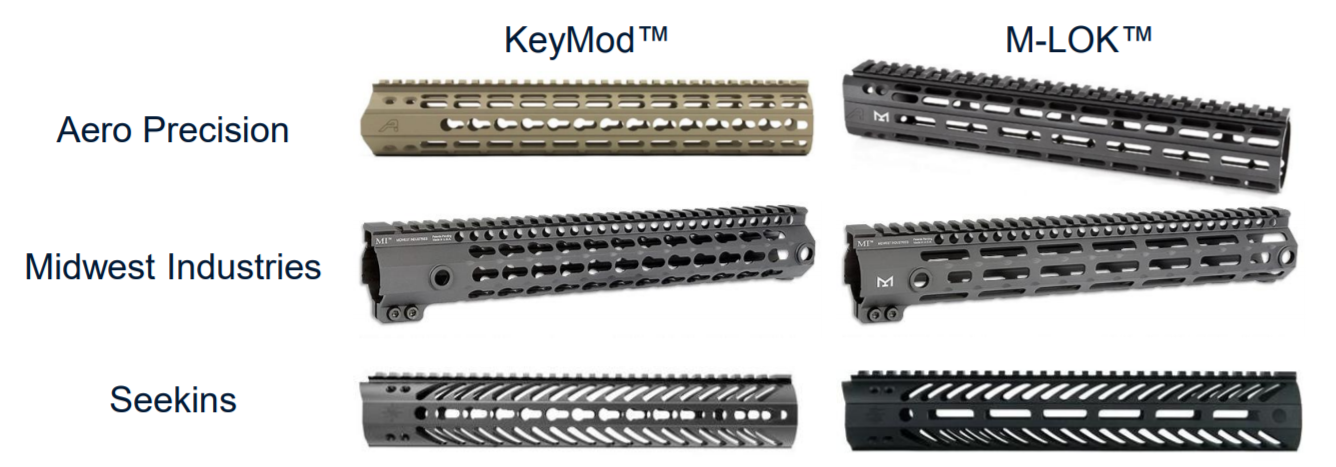
To ensure the results from their testing was not skewed by a particular rail design or manufacturer, SOCOM used three different railed handguards from three manufacturers: Aero Precision, Midwest Industries, and Seekins.
For the test results below, the handguards are labelled as such:
- A1, A2, A3: Aero Precision (KeyMod)
- A4, A5, A6: Aero Precision (M-LOK)
- B1, B2, B3: Midwest Industries (KeyMod)
- B4, B5, B6: Midwest Industries (M-LOK)
- C1, C2, C3: Seekins (KeyMod)
- C4, C5, C6: Seekins (M-LOK)
M-LOK vs. KeyMod: Repeatability (Uninstall / Reinstall)
SOCOM first tested repeatability, or how much point of aim remains the same on a laser sight when removed and reattached to the rail systems. They accomplished this by installing a PEQ-15 laser on both rail systems, measuring its point of aim (POA), removing it, and reinstalling it. They then measured how much POA shifted.
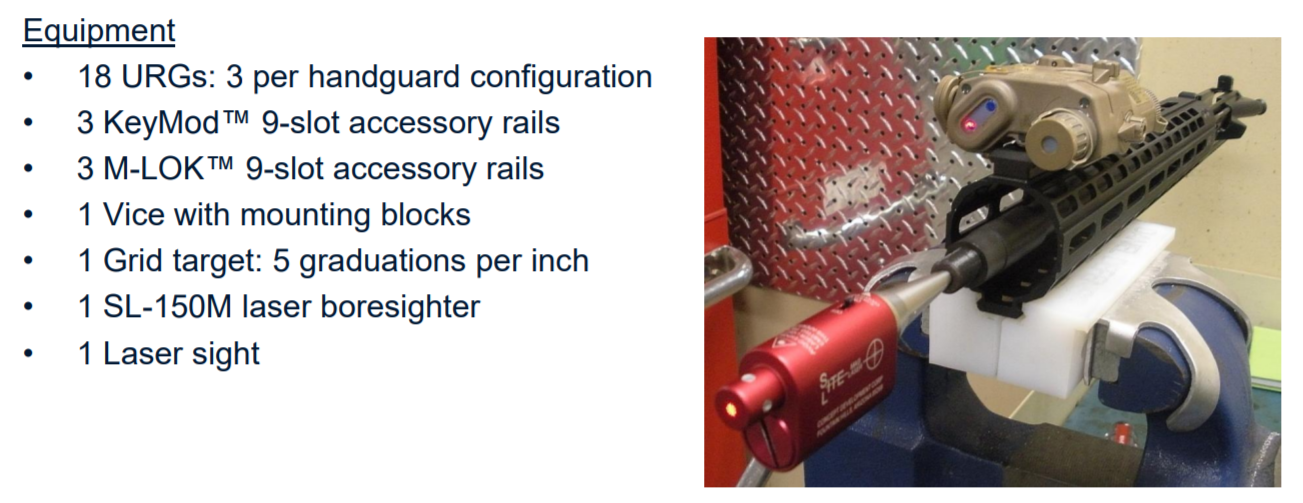
Test Results for KeyMod:
- A1, A2, A3 Average Shift (MOA): 4.4
- B1, B2, B3 Average Shift (MOA): 7.2
- C1, C2, C3 Average Shift (MOA): 3.2
Test Results for M-LOK:
- A4, A5, A6 Average Shift (MOA): 1.7
- B4, B5, B6 Average Shift (MOA): 1.3
- C4, C5, C6 Average Shift (MOA): 0.8
If we average out the shift of point of time for all three sets of handguards, we get an average shift of 4.93 MOA for KeyMod, and an average shift of just 1.26 MOA for M-LOK. USSOCOM even made a nice graph:
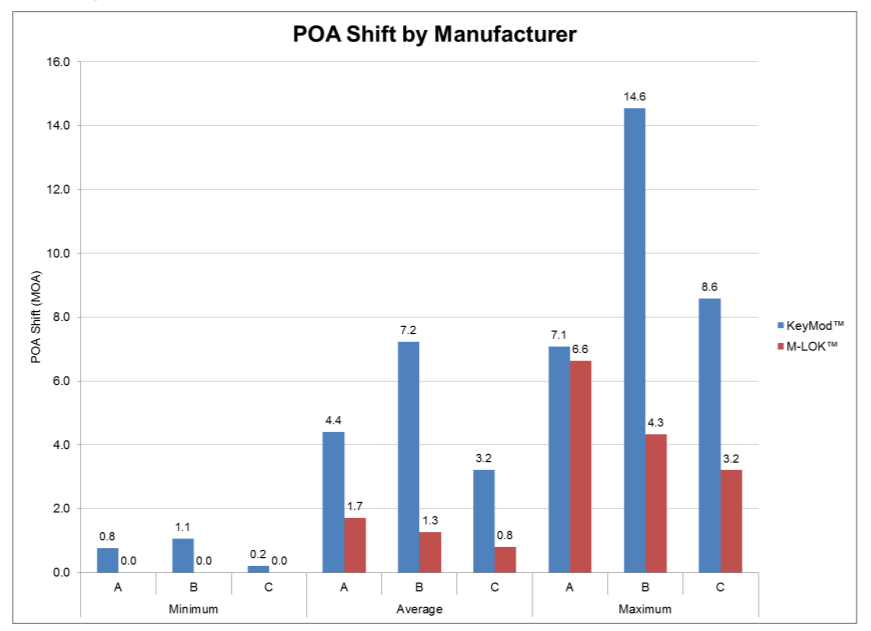
The most telling sign from this graph is the "minimum shift" comparison. KeyMod wasn't able to replicate POA exactly, and shift at least somewhat when reinstalled properly. M-LOK, when properly reinstalled, was able to maintain exact POA with no shift. M-LOK is the clear winner when it comes to removing and reattaching sights or aiming accessories without losing accuracy or having to re-zero your weapon.
M-LOK vs. KeyMod: Simulated Live Fire (Full Auto)
To test the general reliability of both rail systems, SOCOM testers placed an M4 equipped with both rails in a simulated live fire machine. This pneumatic machine produced physical energy waves that replicated full-auto fire at a rate of 1,020 rounds per minute. Thirty-round bursts were used, separated by two-second pauses to simulate mag changes. A total of 20 iterations were conducted, simulating 10,200 rounds per handguard.
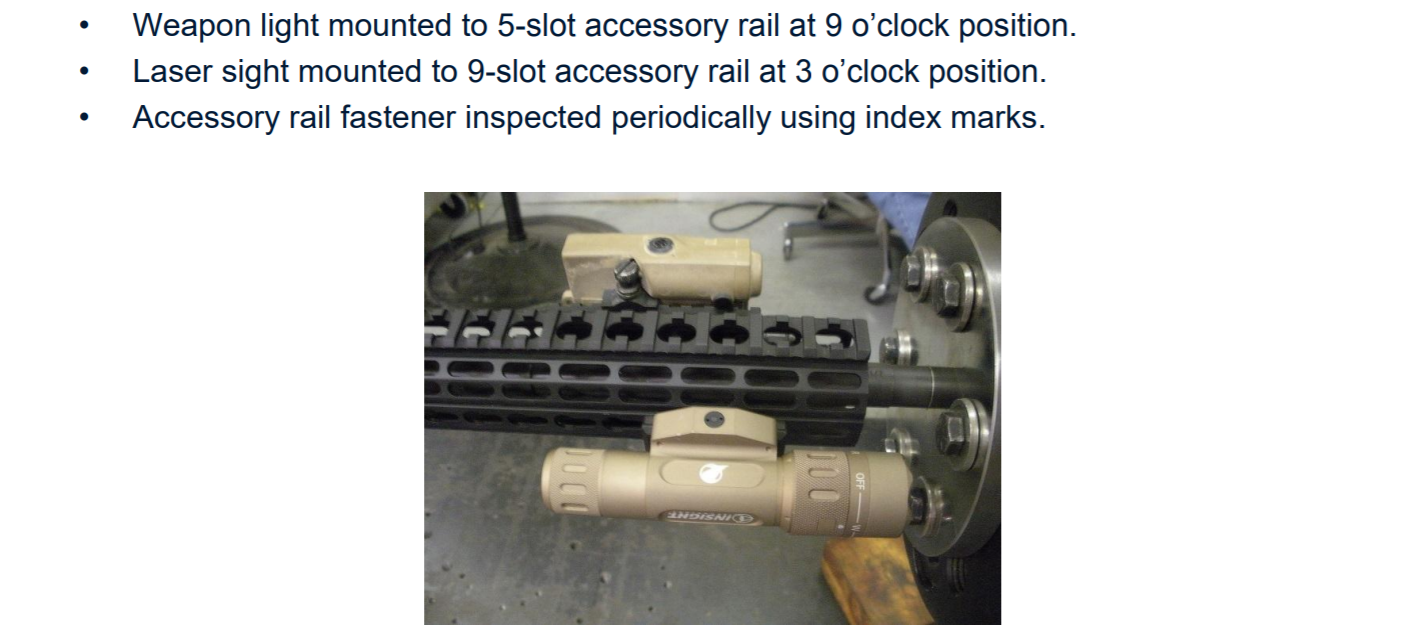
Both rail systems were able to withstand the entirety of the live-fire endurance test without any failure in attachments, mountain lugs, or the rail itself. Neither rail exhibited loose fasteners, either. The endurance test results in a tie for both rails. This is an important test because many who argue which rail is better often claim M-LOK is "more secure" than KeyMod. This test demonstrates that neither rail system has a distinct advantage over the other when properly torqued. KeyMod rails are not more likely to loosen or separate under normal use.
M-LOK vs. KeyMod: Rough Handling Test
What about rough handling? The cyclical forces from live fire may actually provide less of a jolt to your rail system and its accessories than having your rifle or pistol bumped around or dropped. To test this, SOCOM modified the pneumatic live-fire machine to simulate sudden, jarring impacts. These tests were performed at levels of peak load starting at 200 lb. ft. gradually moving up to 400 lb. ft.
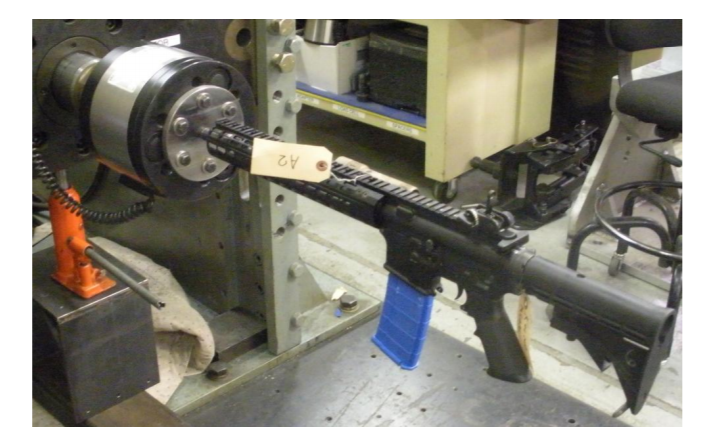
With the same weapon light and laser sight mounted in their usual positions, neither M-LOK nor KeyMod rails failed under the rough handling tests. Both systems maintained tight fixtures with no fasteners coming loose. It is, again, a tie for both rail systems. This further defeats the usual argument that one rail is capable of holding accessories or sights better than the other.
M-LOK vs. KeyMod: Drop Test
Now for the fun part, and the most "proofed" data: SOCOM conducted various drop tests with both handguards to determine which one -- if either -- is truly more rugged and capable than the other. SOCOM conducted six varied drops at different angles and positions to put a proper beating on both handguards:

KeyMod Drop Test Results - Aero Precision
The Aero Precision KeyMod suffered no damage one drops 1, 3, and 6.
The Aero Precision suffer a loose accessory rail attachment, but the accessory (a flashlight) was still in position.
Drop 4 resulted in the rear mounting lug to be pulled through the keyhole. The handguard suffered a crack between the KeyMod slots when this occurred:
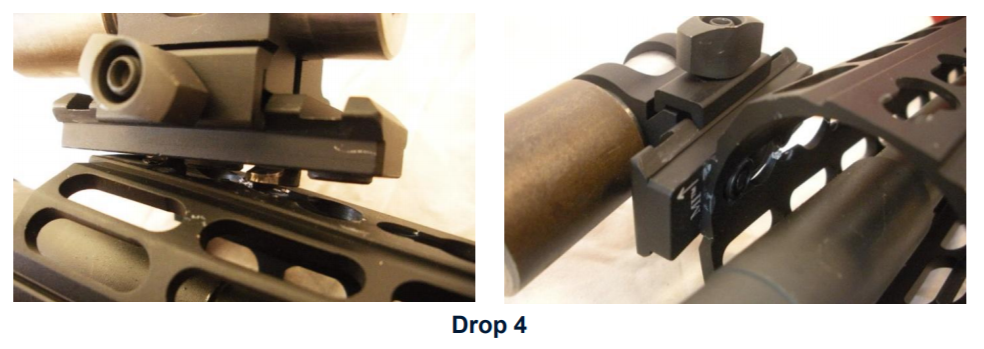
Drop 5 resulted in the the accessory rail becoming detached from the handguard, though no apparant damage was visible to either the mounting lugs or the keyholes:

Drop test #6 was not conducted for the Aero Precision.
KeyMod Drop Test Results - Midwest Industries
- Drop 1 caused the Midwest Industries KeyMod to suffer a fracture on the top-facing rail.
- Drop 2 resulted in no damage to the MI rail.
- Drop 3 resulted in the handguard sliding forward off the barrel nut by approximately 0.5".
- Drop 4 caused the handguard to rotate clockwise on the barrel nut approximately 30 degrees. A small fracture also developed between the KeyMod slots:
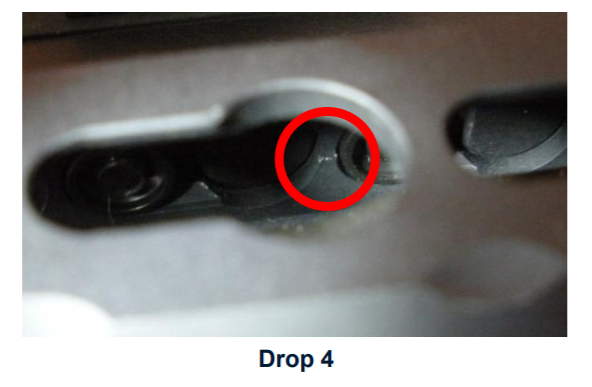
Drop 5 caused the MI handguard to slide further off the barrel nut, which also caused the handguard to no longer be parallel to the barrel.
Drop 6 was conducted twice. The first drop caused total separation of the handguard from the barrel nut.
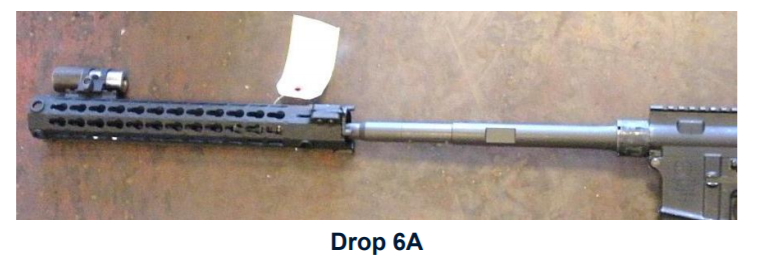
The second drop (6B, not pictured) caused the accessory attached to the keyholes atop the guard to fall off.
KeyMod Drop Test Results - Seekins Rail
- Drop 1 of the Seekins KeyMod rail resulted in no damage.
- Drop 2 only resulted in a scrape on the handguard, but no damage.
- Drop 3 resulted in a slight gap between the handguard and receiver.
- Drop 4 resulted in scraping, but no damage.
- Drop 5 resulted in a fracture between the holes on the rail slots.
- Drop 6 resulted in a major deformation of the rail, but the accessory remained attached.
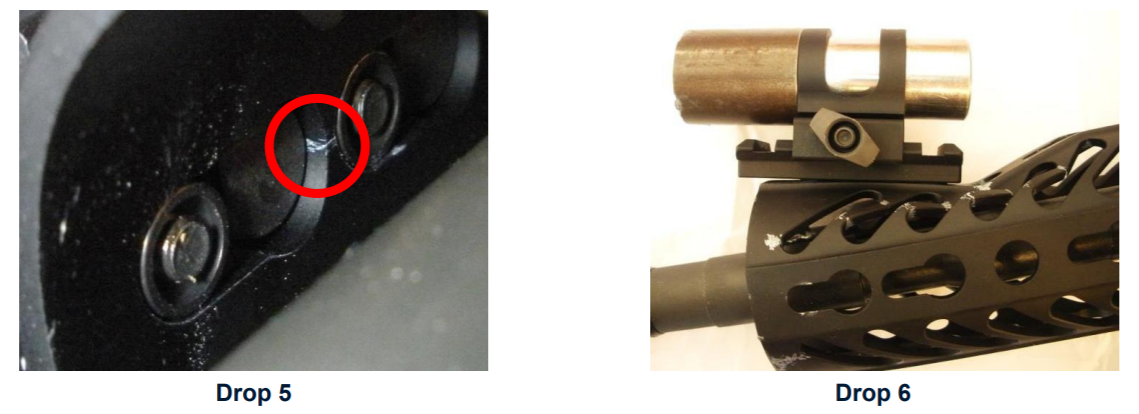
M-LOK Drop Test Results - Aero Precision
- Drop 1 resulted in no damage to the Aero Precision M-LOK rail.
- Drop 2 caused a slight deformation to the rail, with no damage or loosening of the accessory.
- Drop 3 caused the weapon light to slide forward in its mount, but the attachment remained tight.
- Drop 4 caused a fracture in the handguard, but not near the accessory rail.
- Drop 5 caused no additional damage.
- Drop 6 caused the rail accessory to finally loosen and slide rearward in its slot.
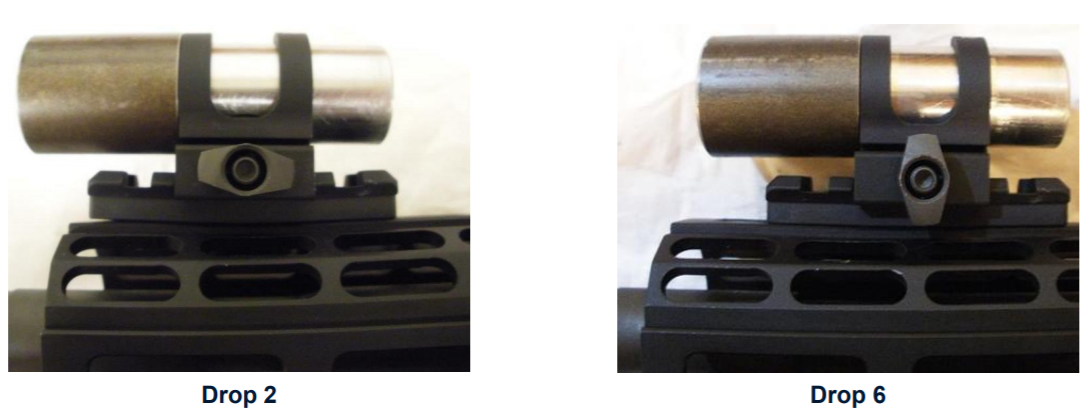
M-LOK Drop Test Results - Midwest Industries
- Drop 1 caused damage to the top rail on the Midwest Industries unit.
- Drop 2 caused no new damage to the rail.
- Drop 3 caused the handguard to slip on the barrel nut and rotate slightly.
- Drop 4 increased the displacement from the barrel nut.
- Drop 5 increased the rotation of the guard to 45 degrees.
- Drop 6 caused the handguard to slide back onto the nut, but it damaged the torque plate.
The attached accessory rail did not loosen or fall off, and remained in place:
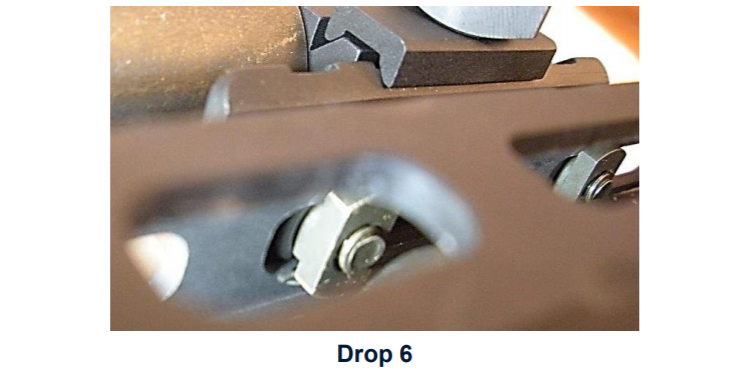
M-LOK Drop Test Results - Seekins Rail
- Drop 1 of the seekins rail resulted in slight rotation of the weapon light in its mount.
- Drop 2 caused no damage.
- Drop 3 caused slight rearward displacement of the accessory rail inside its slot.
- Drop 4 caused additional slight rearward displacement of the rail inside the slot.
- Drop 5 caused no damage.
- Drop 6 caused the accessory rail to slight approximately 50% across the slot:
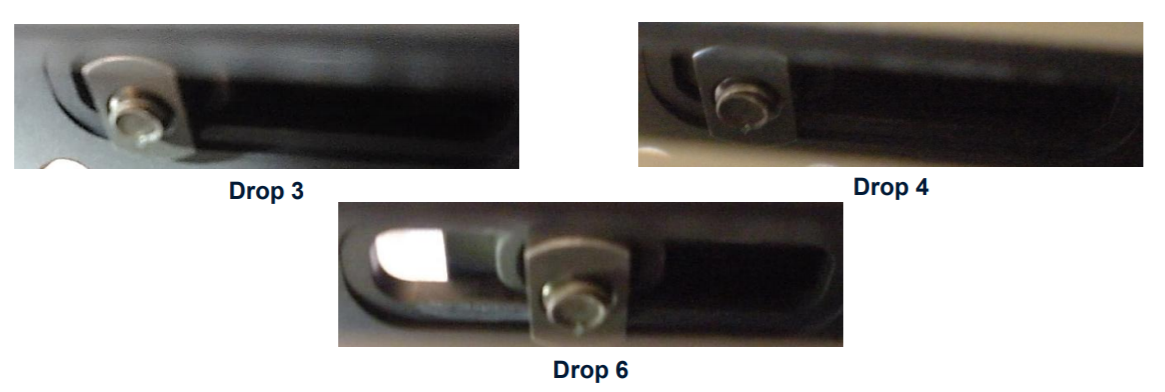
M-lok vs. KeyMod: Drop Test Damage and Summary
The short n' sweet summary is that M-LOK outperformed KeyMod in its ability to retain installed accessory rails without significant damage to the rail section holding the accessory. The M-LOK rails were able to retain their accessory rails with minor slippage, but without losing the accessory completely. The KeyMod rails often fractured, causing the conical lugs on the accessory attachment to be pulled off the rail.
KeyMod Rails After Drop Tests

M-LOK Rails After Drop Tests
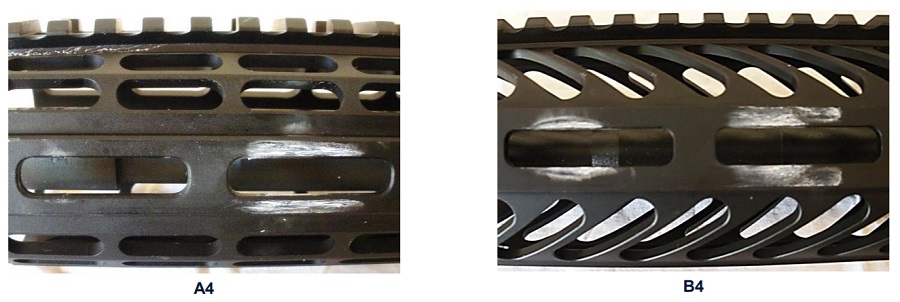
Final Test: M-LOK vs. KeyMod Failure Load
This final test was designed to determine which rail system could hold onto its attached accessories when pulled under extreme loads. Both rail systems' attached weapon lights were pulled with a metal chain until the force was great enough to destroy the attachments and separate the rail attachment from its handguard slots:
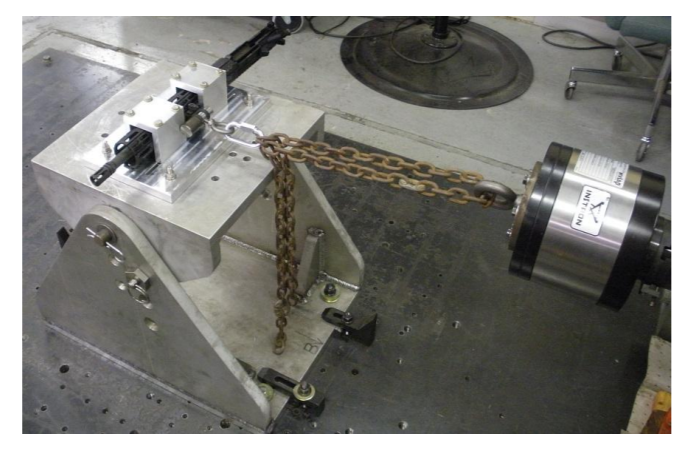
The results speak for themselves. Below, the graph illustrates the total pound-feet required to caused separation of the attached rail from the handguard's slots. All six handguards were tested until failure:
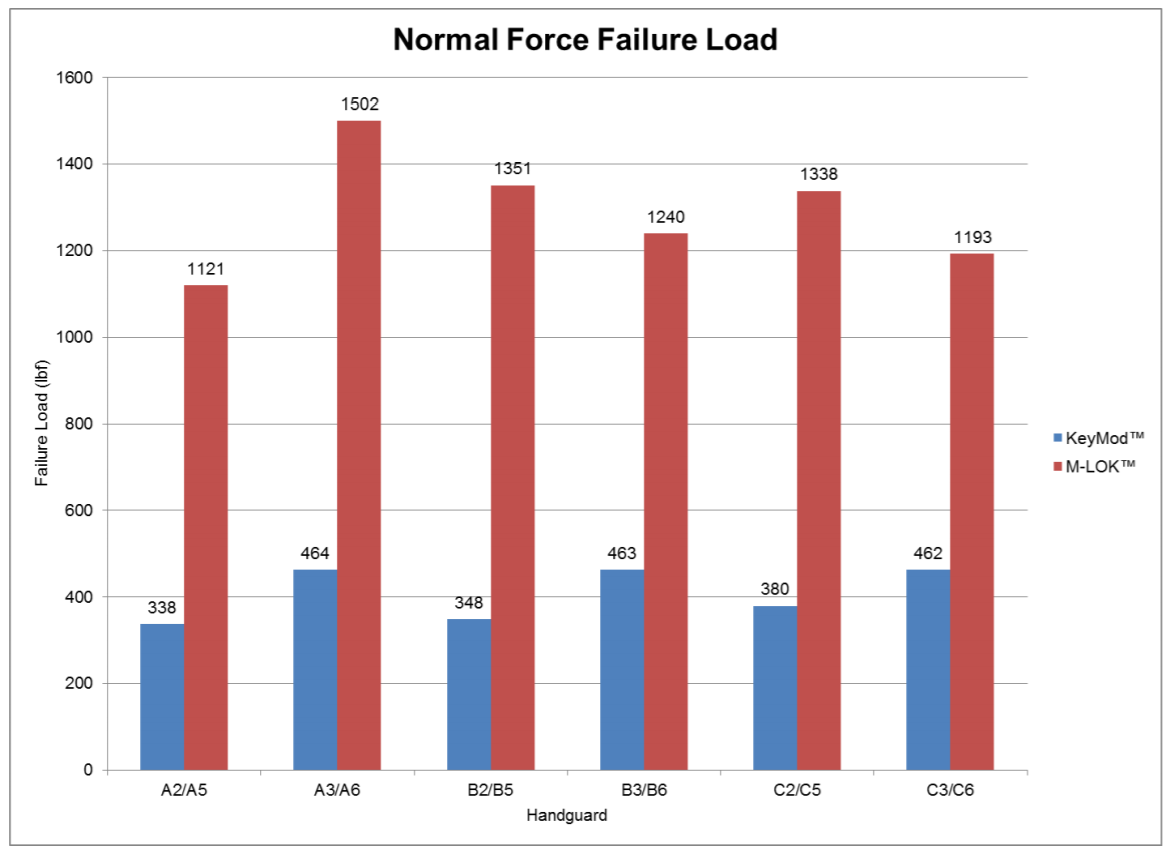
On average, M-LOK was able to withstand approximately 215% more force before failure when compared to KeyMod.
Final Summary of M-LOK vs. KeyMod: Who's The Winner?
Repeatability
M-LOK achieved a 73% improvement in average point-of-aim shift compared to KeyMod.
Endurance
KeyMod and M-LOK tied for endurance, with both rails passing the live-fire test.
Rough Handling
KeyMod and M-LOK also tied for rough handling, with both rails suffering no failures during rough handling.
Drop Test
M-LOK was the clear winner. 100% of M-LOK rail attachments remained attached, but only 33% of the KeyMod rail attachments remained attached.
Failure Load
M-LOK was again the clear winner. It was able to withstand more than 3 times the force of the average KeyMod rail system before failure.
DISCLAIMER: If you are new to the world of DIY gun building, you likely have a lot of questions and rightfully so. It’s an area that has a lot of questions that, without the correct answers, could have some serious implications. At GunBuilders.com, we are by no means providing this content on our website to serve as legal advice or legal counsel. We encourage each and every builder to perform their own research around their respective State laws as well as educating themselves on the Federal laws. When performing your own research, please be sure that you are getting your information from a reliable source.

